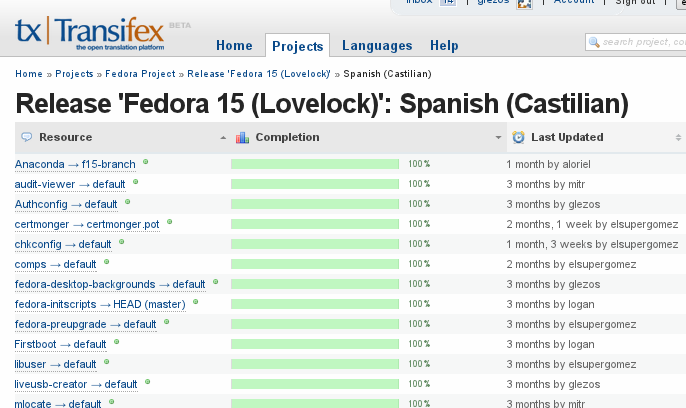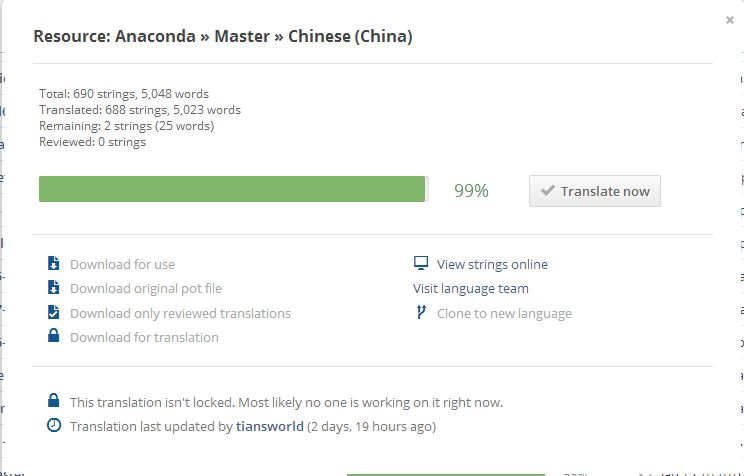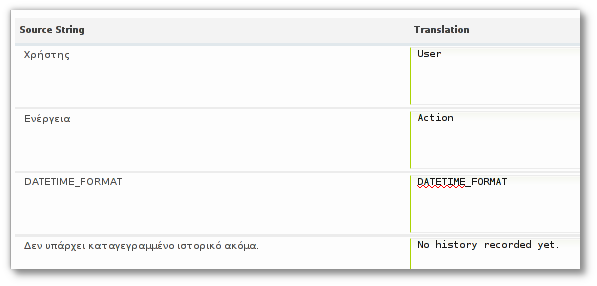Fedora 本地化工作向导(不断完善中。。。)
简介
这份指南为翻译 Fedora 项目和文档提供一个快捷、简便、带有步骤的指导。您可以在本页面的末尾找到 FAQ。
Fedora 本地化项目的网址为 https://fedora.transifex.net/。
寻求帮助
您可以将问题张贴到 trans 邮件列表,还可以通过因特网中继聊天(IRC)在 irc.freenode.org 上的 #fedora-l10n 房间寻求帮助。
您还可以在 Transifex 上看到许多信息:http://help.transifex.net/。
成为 Fedora 翻译人员
最开始您需要注册以获得翻译材料的访问权限:
您的自我介绍非常重要。它能提升您被批准拥有写入权限的机会。您可能也想 新建一个 Bugzilla 账户 解决用户报告的 bug。
开始使用 Transifex
Fedora uses Transifex to manage its localization workflow. These steps will guide you through the creation of a Transifex account and joining your team.
新建一个 Transifex 账户
- Visit https://fedora.transifex.net/ and click on the top-right corner "Register"
- Fill-in the form and click Register! You can use your Fedora email or the same email you used to create your Fedora account. Choose a good password (as described above). This password can be resetted if you forget it, though.
- Check your email. An email should arrive soon to verify your email address. There will be a link in it — click it!
- You should be able to login on Transifex with your credentials now.
加入与您使用的语言有关的 Fedora 翻译团队
- Visit the Fedora Teams page at https://www.transifex.net/projects/p/fedora/teams/.
- If your language is there, click on it.
- You should see a list of the members, the leader (coordinator). Click "Join this team" to ask to join the team.
- The team leader will receive a notification about your request. He will check your information, and check whether you introduced yourself.
- If all goes well, the maintainer will accept your application, and you'll receive a notification.
This may take between a few hours or days. If takes more, click on the maintainer's username on Transifex and send him a message asking him for more information.
订阅邮件列表
- Visit https://admin.fedoraproject.org/mailman/listinfo/trans and subscribe to the main translation mailing list.
- Wait for the confirmation email which contains a link to confirm your subscription. Click the link to confirm your subscription.
Check https://fedoraproject.org/wiki/L10N/Teams to see if there is a special mailing list for your language. If so, subscribe to that list too.
介绍一下自己
- Create a personal page at https://fedoraproject.org/wiki/User:Username. This is very useful for Fedora contributors to get to know and contact each other. You'll need to create a Fedora account for that.
- Post a short self introduction to the trans mailing list and to the list of your local team with instructions from https://fedoraproject.org/wiki/L10N_Self_introduction. Please remember to include your FAS user name and your language. With this information, your language leader can identify you and approve you as a translator on his team.
新建一个Bugzilla账户
If you are asked to use Bugzilla, create an account by visiting https://bugzilla.redhat.com/bugzilla/createaccount.cgi.
新建一个Fedora账户
The steps below guide you through the creation of a Fedora Account.
账户申请流程
- To sign up for a Fedora account, first visit https://admin.fedoraproject.org/accounts and select New Account.
- Fill in Username, Full Name and Email, and click Sign up!. Your password will be emailed to you.
- Go back to https://admin.fedoraproject.org/accounts and log in with your password. The welcome page will be displayed, and it reminds you that CLA is not completed.
- Telephone Number and Postal Address fields are also required to fill in for signing the CLA. These information is NOT accessible by others except admin groups. Please refer to Fedora Privacy Policy at https://fedoraproject.org/wiki/Legal:PrivacyPolicy.
- Other fields will be displayed by any other member by visiting the user's view page.
- Now click Save! located at the bottom of this page to save your information.
签署CLA协议
You must complete the Contributors License Agreement, or CLA.
- Visit https://admin.fedoraproject.org/accounts and login your account using your user name and password obtained from the previous process.
- In the Welcome page, click complete the CLA or go to https://admin.fedoraproject.org/accounts/user/edit.
- If the information of telephone number and postal address have not been provided yet, the Edit Account (user_name) page will be appeared. Otherwise Fedora Contributor License Agreement page will be displayed. Read through the agreement carefully and click I agree if you are happy to do so.
- The user-view page is appeared and shows the CLA: field as CLA Done.
开始翻译
The translatable part of a software package is available in one or more PO files. Some projects might use other file formats as well, such as QT TS ones. These files may be maintained in any of a number of version control systems (VCSs) depending on the project, such as Subversion, Mercurial, and git. They may be hosted on either fedorahosted.org or other systems.
This chapter explains how to translate the projects which use Transifex to manage their L10n workflow. Translators can work on the web interface or the command-line to obtain and submit files. Before you start, you must first prepare the directories which hold your po files.
列出所有可被翻译的Fedora子项目
- Visit https://www.transifex.net/projects/p/fedora/.
- Choose the type of Fedora Projects you want to translate by choosing the appropriate Release. You should see Fedora itself, Fedora Documentation and other upstream projects. Click on the release you choose to contribute to. For example, click on the link pointing to https://www.transifex.net/projects/p/fedora/r/fedora-15/l/ja/.
- The new page shows the full statistics for this release per language. Choose your language.
- This page shows all translatable resources (ie. files) for this release. Click on one of the table rows to get information on the resource you're interested in.
You can bookmark this page for future reference. We'll call it the "Language-Release" page from now on. Here's an example URL:
https://www.transifex.net/projects/p/fedora/r/fedora-15/l/ja/
在线翻译
The easiest way to translate is by using the Transifex Web Editor. It's an intuitive interface which does not require you to download files on your system and re-upload them back.
- Follow the instructions above to locate the resource which interests you.
- On the popup, you should see a "Translate Now" button. If you are logged-in on Transifex and a member of the language team, it should be clickable. Click it!
- You should now be in the Transifex Web editor (codenamed Lotte). Go on and translate as much as you want, and at the end, click "Save and Exit".
Note: When you translate online, the file is automatically "Locked" and other people are notified about your work. Never translate something that another translator has already locked -- you might be overwriting his own work!
离线翻译
If you prefer to translate offline, you can simply download & upload a translation file.
Before you download any files, we suggest you prepare a directory to hold your files. The described structure below is an example only, and your structure can be formed differently.
mkdir -p ~/fedora-translations/
Obtaining and Translating Projects
You can download a file to translate. You may need to communicate with other translators in your language team to avoid conflict. If you are not sure, please contact your language coordinator. Also locking a file will avoid potential conflicts.
- On your Release-Language page find the resource (table row) you want to translate and click on it for the popup to appear.
- Click on "Download for translation" button to download the file as the name of your choice to the directory you created in the previous section (e.g. abrt.po).
- Now the file is on your local workstation and ready for translation. Translate the file into your language eg. with a POeditor of your choice such as Lokalize or gtranslator.
- Check the integrity of your file before commit using
msgfmt -cvo /dev/null abrt.po. If any error messages appear, correct it before commit.
Please note that all files offered from Transifex are already merged (msgmerged) with the POT files. This happens both when you download and when you upload files.
提交您的翻译内容
Once you finish translation work, commit the file using the same interface.
- Make sure you are logged in on Transifex.
- Navigate back to your Release-Language page and click on the resource you want to upload to. Be careful not to upload on a different resource.
- Click on the "Upload" button and locate your translated file on your local system, and Submit it. The interface might take some time (for large files up to one minute) and finally notify you that the file was submitted successfully. If you receive an error or some other message, please post it to the Fedora Localization Project mailing list so it can be addressed.
加入新文件
If one of the resources in the release is missing your translation, you should see it missing from the release page, and see a separate list at the bottom of the page as follows:
The following resources don't have any translations in Japanese: 1) python-fedora → python-fedora.pot
- Click on it -- it will take you to that resource's main page.
- Click "Add Translation"
- Choose your language and click "Translate Online".
- Go ahead and translate online a few or all the strings, and then "Save and Exit".
Proofreading Software Translations
Since Fedora 12, the composed live image has been available to download for reviewing and correcting software translation in user interface. This live image is composed around a week before Fedora Software Translation Deadline and made available by deadline date. This image should include all latest translation submitted at this point.
To proofread your translation as part of the software, follow these steps:
1. Change directory to the package you want to proofread. For example:
cd ~/myproject/system-config-printer/
2. Convert the po file to a mo file using msgfmt with -o option:
msgfmt -o system-config-printer.mo ja.po
3. Back up the existing file and overwrite old one.
su - cp /usr/share/locale/ja/LC_MESSAGES/system-config-printer.mo system-config-printer.mo-backup mv system-config-printer.mo /usr/share/locale/ja/LC_MESSAGES/ exit
4. Proofread the package with the translated strings as part of the application. The application related to the translated package runs with the translated strings.
LANG=ja_JP.UTF-8 system-config-printer
翻译 Fedora 文档
Translating Fedora docs is exactly the same as translating software, so just follow the same instructions as above. Make sure you select the "Fedora Documentation" Release, which will lead you to a separate Release-Language page, specialized in Docs.
Example:
https://fedora.transifex.net/projects/p/fedora/r/fedora-docs/
Understanding the Multiple Files Structure
Fedora Docs mostly use Publican. Unlike software, a guide has multiple po files structure. Each file corresponds to each chapter in that guide. The file name usually consists of the chapter name. This structure is very useful as more than one translator can work on certain guide same time.
New languages: Creating docbook-locales File
If you are creating the first-ever translation for a locale, you must first translate docbook-locales file used in all documents for your locale.
- Navigate to the docbook-locales Transifex project: https://www.transifex.net/projects/p/fedora-docbook-locales/resource/locale/
- If your language is not there, just add it.
- File a bug in Bugzilla against Product "Fedora Documentation" with Component "docs-requests". You may leave the details blank, or name the guide name(s) which you like to translate. Attach Files if Necessary. If you have any problems submitting po files using above instructions, you can attach it to the bug.
- Use the following Summary on the bug: "[ja]: New language support request."
发布您的成果
当您的文档翻译已经准备好可以发布在 Fedora 文档网站 上时,请依照以下步骤提交一份正式的翻译发布请求:
- 在 Bugzilla 提交 针对 Fedora 文档产品 publishing-requests 组件的 bug。记得在描述区域注明您想要发布的文档的名称与语言版本。如果您想要一次发布多份文档,请为每份文档分别提交 bug。
- FAS 中 docs-publishers 群组的成员会被提醒有您的请求,然后会发布您的翻译。一旦翻译得到发布,他们会为您关闭 bug。
什么样的文档需要翻译
对每个 Fedora 发行版本来说最重要的文档有:
- docbook-locales
- Common Content for Publican(Publican 常规内容)
- Publican branding for Fedora
- Documentation website(文档网站)
- Release Notes(发行注记)
- Burning ISOs(刻录ISO)
- Live Image(Live 镜像)
翻译 Fedora 项目网站
Fedora 网站同样可以通过 Transifex 进行翻译。您可以在 Fedora Websites Release 找到所有 Fedora 网站相关的项目:
https://www.transifex.net/projects/p/fedora/r/fedora-websites/
下载、翻译、提交网站项目,流程和软件项目的一样。请注意新翻译不时就会拉取,根据发布状态,周期可能是每天或是每周一次。如果您注意到已经有一段时间没有更新您的翻译,您可以在网站团队的邮件列表上请求更新。通过添加 L10n 邮件列表到抄送,您可以告知其他团队您已经请求了更新。
加入新的 .po 文件
添加新的 po 文件的方式和软件项目的一致。如果您是有史以来第一次为一个 locale 新建翻译,您必须提醒 Fedora 网站团队把新语言添加到网站上。向 trans 邮件列表发布请求,以使网站团队可以把这个语言添加到网站的 Apache 配置中。
校对
一般说来,网站团队会提供测试站点以供校对。
翻译维基页面
Fedora Wiki 是项目相关信息的仓库。其中的一些页面需要被翻译以更好地服务 Fedora 社区。这一章会一步步地解释翻译维基页面的正确方法。
找到待翻译页面的英文版本
英语是 Fedora 项目维基的基础语言,所以首先需要有您要工作的页面的英文版本。(如果您要翻译的页面没有英文版本,参考下面的“处理没有英文版本的翻译”。)
如果页面顶部已经有一个语言模板,点击语言盒子右边的 edit 链接,跳到第 4 步;否则,继续看第 2 步。
如果您新建的页面没有英文版本,请新建一个新页面用于英文版本,添加模板 { { template|autolang } },
然后添加模板 {{needs english}}。这会标识这个页面需要英文翻译,同时会新建一个基础页面。
在英文页面顶部加入语言框
编辑英文页面,在页面顶部添加模板 { { template|autolang} }:
{ { autolang|base=yes } }
base=yes 部分对于英文页面是必需的。保存这个页面。
创建语言模板
{ { template|autolang } } autolang 模板应该会提供一个链接让您设置好语言盒。点击它会出现一个编辑页面。 不要更改任何内容,保存页面。然后点击语言盒右边的 edit 链接。
加入您使用的语言到模板中
到这一步您应该有了一个编辑框,其中有模板语法类似:{ { lang|en|page=Base page name } }
在 lang 和 page= 之间的文本是语言代码的列表。把您打算翻译到的语言的代码添加到列表中去。 使用下面的列表确定正确的 MediaWiki 语言代码。
http://fedoraproject.org/wiki http://svn.wikimedia.org/viewvc/mediawiki/trunk/phase3/languages/Names.php?view=markup
请保持列表的字母序:保持语言代码的列表依照代码的字母顺序排列。举个例子,这意味着德语(de)应该出现在英语(en)之前。
开始创作新页面
点击对应您的语言的红色链接以打开新页面。在页面顶部插入模板 { { autolang } },以使得语言列表出现在那里。 确定非英语的子页面的模板中不包含 base=yes。
移动已翻译的旧页面
对于不在正确位置的已翻译页面,请遵循以上的 1-4 步。然后复制新页面的标题(例如 Fedora Project Wiki/de)。 点击就业面顶部的 move 链接,把新页面名字粘贴到新标题区域。编辑新页面,在顶部添加 { { autolang } }。
FAQ (常见问题)
这里有一些有关本地化项目的常见问题。
我应该翻译法律声明吗?
不。您绝不要那么做。法律声明的准确措辞非常重要,不被律师认可的翻译版本非常冒险。Red Hat 是 Fedora 项目的法律代表和主要赞助商,它没有资源去对每一个翻译做交叉检查。当涉及到法律事务时,保持原始的英文声明原封不动即可。
How do I report issues?
Before reporting (either opening a new ticket or the list), please search to see if there's an existing report opened. It sometimes help to ask in #fedora-l10n if there's a known issue at that exact moment. If not, please open a ticket describing what's wrong with the service in clarity. Include the nature of the problem, the project/resource, the time (in UTC) it happened and your Fedora username. If you suspect it might be a problem with the particular file you are uploading or the target file, include that information as well.
Where do I report issues?
- Issues specific to Transifex should be reported using the "Feedback" button on the right-side of the website.
- These include: Questions related to Transifex, possible bugs, feature requests, problems you are having with the site, such as a slow webpage, login issues.
- These do not include missing Fedora projects, Fedora team creation requests, Fedora coordinators etc.
- Issues specific to Fedora L10n should be first reported on IRC (#fedora-l10n) and then on the trans- mailing list.
- These include team questions, releases, projects, Fedora maintainers, developers etc.
- These do NOT include questions Transifex bugs, feature requests, problems you are having with the site, such as a slow webpage, login issues, or wrong statistics because a project is missing from the release.
Where do I report feature requests?
Please see above section, 'issues specific to Transifex'.
How do I create a new team? (#new-team)
See L10N Maintainer on how to become a maintainer of a new language.
My file is 100% but when I test the application I still see English strings! (#missing-strings)
This wasn't a question, by the way. Nevermind. The following might have gone wrong:
- The strings in question have not been marked for translation by the developer, hence they haven't been included in the POT file, and thus not in the PO file. He needs to use gettext on them.
- The source files of these strings have not been marked for inclusion, in the intltool case.
- The POT file of Transifex is not up to date. The component page includes the date when the POT file has been produced. If this is more than a few hours in the past, please notify the admins, otherwise it should be OK.
Are the statistics live? How often are they updated? (#update-frequency)
The statistics on Transifex are always live on the project pages. The Release pages are updated once per day.
How do I add a module to Transifex? (#add-transifex)
- Navigate to https://www.transifex.net/projects/add/
- Follow the instructions from http://help.transifex.net/intro/projects.html
If you want the Fedora Localization Project to handle your translations (i.e. you are NOT an upstream project):
- Click 'Access Control' on your Project Details Page
- Outsource team control to "The Fedora Project"
- Send an email to fedora-trans-list and let the contributors know about the change. One of the Fedora L10n Editors will add your project to one of the Fedora releases.
Here are two more pages you might want to read:
- http://lists.fedoraproject.org/pipermail/trans/2011-January/008573.html
- http://lists.fedoraproject.org/pipermail/docs/2011-February/013109.html
I'm a developer, how can I make .desktop files translatable?
Transifex will natively support .desktop files soon.
I can't find "About this Computer" string. Where is it?
It can be found at AboutThisComputer.
Is the section of export regulations shown at the bottom of the fedoraproject.org/get-fedora page translatable?
No. This is purposely set up as non-translatable. Please refer to Non-translatable export regulations?.
If some strings change past string freeze, how do I request a string freeze breakage?
Email the trans mailing list!
What if I overwrite a wrong file?
If you have overwritten a wrong file in your own locale, try to find the old file on the developer's git repo (http://git.fedorahosted.org/git/) and replace the wrongly updated file with this file.
Even though these are measures to correct mistake, we strongly advice you to take extra care while submitting the translations via Transifex and make sure that you are uploading file in proper location under proper locale because some projects don't keep translation files under their CVS tree (do I say "Anaconda" ? oO)
I'm from the Docs Project. How do I make my Guide / Release Notes / other document available for translation?
If you keep you document in a git repository, see Setting up a document with Transifex to find out how to make it available to translators on Transifex.net.
本指南编写人员
以下人员参与完善本页面:
- Manuel Ospina
- Paul W. Frields
- Noriko Mizumoto
- Dimitris Glezos
- Diego Búrigo Zacarão
- Piotr Drąg
- Misha Shnurapet
- Petr Kovar



